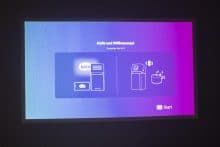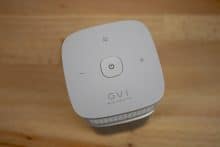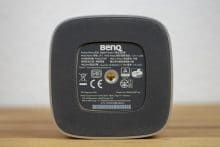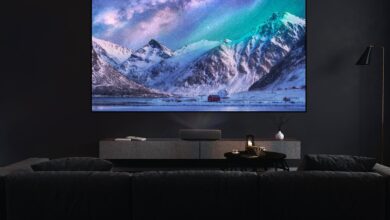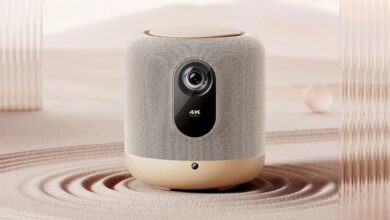
Beamers are usually highly inflexible and difficult to operate. If we buy a beamer, we usually have to go through a lengthy assembly process, after which the device is firmly attached to the ceiling. If we want to use it in another room, we are faced with a problem because we have to dismantle it and install it again. With the GV1 from BenQ all this should be completely different. This device is a mobile beamer that can easily be set up and used anywhere. We wanted to test whether the device is actually as practical as it claims to be. The following lines tell you more about the mobile beamer.
Set-up and Operation
The supplied remote control must be used to set up the beamer. Operating instructions are not included, but are not required. All steps necessary for setup are displayed graphically on the beamer. The user only has to follow the steps shown.
In the test we were able to set it up in a very short time without any problems. Updates can be installed as soon as the beamer is integrated into the home WLAN network. The beamer is also equipped with a battery that lasts up to three hours, a mains cable that can be connected if required, an on/off switch, volume buttons and a tripod thread. As was to be expected with a mobile beamer, the device is very small and handy.
All in all, setup and operation are child’s play thanks to the graphic accompaniment and can be completed in no time at all.
After setup, the connection can be established with various devices – usually wirelessly at the touch of a button. More about the connections and connection possibilities can be found in the next section of our report.
Connections and Other Connection Options
When considering the connection options, large differences to conventional beamers are noticeable. For example, BenQ’s GV1 does not have an almost mandatory HDMI connection. This circumstance could be interpreted as a disadvantage which makes the mobile beamer lag behind its stationary competitors. On the positive side, however, the lack of HDMI connection is an indication of the fundamentally different nature of the mobile beamer. The GV1 from BenQ does not want to compete with the stationary beamer and is certainly a bad choice if it is to be used permanently in a very specific setting. It is designed for mobile use, where locations and environments are constantly changing. An HDMI connection is not conducive for such purposes and therefore does not exist.
In mobile, flexible use, flexible connection options are more effective. For this reason, BenQ expressly relies on these flexible connection options for its mobile beamer. The device is expressly designed for wireless connections. Connections to Android and iOS devices can be established via Bluetooth and WLAN.
On these devices, the beamer can be ideally synchronized via Google Cast or AirPlay. If Chrome is used as a browser on a Windows PC or laptop, synchronization can also take place here. Google Chrome can transfer both individual tabs and the entire screen. If you prefer a cable connection, you can use the USB-C port of the beamer. Modern smartphones and laptops can thus be easily connected by cable.
In the test we tried out the different connection options and could convince ourselves of the functionality of the beamer. The wireless connections are very convenient. Once again, it is clear that the target group of the mobile beamer differs significantly from that of the classic stationary device.
If you do not want to connect an additional device, you can also install some apps from the pre-installed App Store, such as Firefox, YouTube, Netflix or VLC. So the BenQ GV1 can also be used independently.
Image Quality, Sound and Orientation
When it comes to image quality, the special target group of the mobile beamer must again be taken into account. If you want to set up a home cinema system, the GV1 from BenQ is a bad choice. If, on the other hand, you want to throw Netflix streams against the wall every now and then, watch videos and films on a big screen on holiday or play presentations to customers, the GV1 may be the right choice for you. The image quality can by no means compete with that of a stationary beamer. Not even HD is possible with BenQ’s GV1. At 420p, it’s over. However, this resolution is absolutely sufficient for a mobile beamer that will certainly not be used in professional film contexts. The beamer is suitable for a film evening with friends, for streaming a football match or for similar purposes, even if the contrasts could be higher. You can forget to read texts with the resolution, unless you throw the picture onto a big screen and are accordingly far away. The high flexibility of the device, which will probably be the decisive buying incentive for many interested parties, is bought with a rather limited image quality. Those who expect high image quality will probably not be satisfied with the BenQ GV1. Those who have a power connection nearby should therefore look for another beamer that has a stronger luminosity and a higher contrast – and ideally also a higher resolution.
The Auto-Keystone function is a special plus here: Conventional beamers usually prove to be stubborn and difficult to use when it comes to obtaining the straightest possible picture. This is no problem with the mobile beamer. The Auto Keystone function ensures a straight, rectangular image without any manual intervention. In our practical test, this function worked wonderfully and ensured that the beamer was immediately ready for use.
What has already been said about the picture applies to the sound: It is by no means outstanding, which cannot be expected from a mobile beamer either. But the sound convinced us more than the picture.
Fulness
The GV1 by BenQ* is absolutely flexible and extremely practical. With just a few clicks, the beamer is ready for operation in any situation and at any location. There is no need for time-consuming connection and setup. You can start right away. On the other hand, picture and sound quality are rather modest compared to stationary beamers, which do not offer any flexibility. However, they are completely sufficient for the purposes of a mobile beamer. Even largely missing cable connections can be coped with, as they would not be an advantage with a mobile device anyway. All in all, the beamer can be convincing if its special areas of application are sufficiently appreciated. The GV1 from BenQ will never be able to replace the high-tech projector used in home cinema. This high-tech beamer is not able to throw a stream onto the house wall during the World Cup, onto the cellar wall during the birthday party, onto the living room wall during the Netflix evening and onto the living room wall of friends while watching holiday videos. In short: The GV1 is extremely flexible and this is exactly where its strength lies. In his niche he is ingenious and can hardly be compared with stationary beamers who are supposed to perform completely different tasks.
BenQ GV1
Setup and Operation
Connectors & Connection
Image Quality
Sound Quality
Flexibility
Value for Money
An absolutely flexible and mobile beamer.







